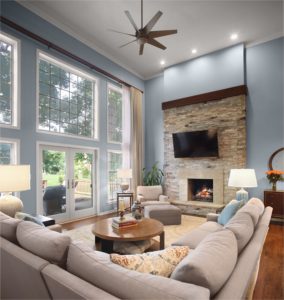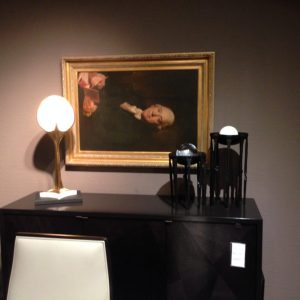Originally appeared online at Philly.com in Home & Design
In any room, one element should arrest attention as if it is in a spotlight. In the living room, the starring role often goes to the fireplace. In a bedroom, the honor might go to an ornate headboard or antique wardrobe. These eye-grabbing design features are called focal points, which help guide the selection and placement of the rest of a room’s décor. Use furniture and furnishings to complement and emphasize the focal point, says Kathy Alexander, founder and president, Alexander Interiors, McLean, Va. A focal point should stop short of being a show-stealer. Rather, it should draw attention and then encourage the viewer to take in and appreciate the rest of the room. Like a movie star, a focal point needs a supporting cast to realize its full potential. This cast consists of carefully selected furnishings and accessories arranged in such a way that the eyes rove about the room and are eventually drawn back to the focal point. “This can be done through the use of color, pattern and lighting,” Alexander says. Keep in mind basic design principles such as balance, rhythm, scale and proportion, and harmony. Built-in Focal Points Often, a focal point is established by architecture, as is the case with a traditional fireplace, says interior designer Marilyn Lewis of Marilyn Lewis Design Group, Salt Lake City. “Usually, the scale of the focal point is what draws the eye to it.” The focal point visually anchors a room. Fixtures, furniture and accessories should be proportionate to the focal point and arranged around it in a way that looks balanced. On the wall opposite a fireplace, you might place a credenza, framed mirror or piece of artwork for a balanced effect, Lewis says. Seating is often oriented around the focal point, be it a fireplace or a bucolic view framed by a picture window. The star player dictates the color palette and types of materials used throughout the room. If the star is a rustic stone fireplace, make certain rough, earthy elements appear throughout the space, perhaps with accessories like pottery or bookends, or even rough woolen upholstery. Contrast and variety are just as important as repetition when designing around a focal point. A couple of smooth throw pillows with a silky sheen will complement a craggy fireplace provided they tie in with the room’s “overall sensibility,” perhaps by calling out in a bolder tone one of the subtle colors in the stonework, Lewis says. Think: Exclamation Point A focal point is not always an architectural element but can be brought into a space to assume a starring role by virtue of scale or color. Take, for example, a tufted-leather sofa in a brilliant teal. “There are so many wonderful ways you can get that color bounding around the room,” Lewis says, but just as an exclamation point here and there. Neutral colors, such as soft wheat or pale gold, should prevail throughout the rest of the room so as not to steal the sofa’s spotlight. Sometimes, a strong architectural feature like a fireplace will compete with your intended focal point. “If you enter a room and you immediately see a dramatic landscape beyond, that would be your focal point or emphasis,” Alexander says. “The fireplace should be downplayed by pointing the mantel a soft white or neutral so it doesn’t detract from the view.” In such a space, stardom can be transferred back and forth but not shared, depending on time of day. “During the day, the focal point is the expansive view, but at night, especially with the window treatments closed, the focal point would likely be the fireplace,” Alexander says. Give the fireplace its due. “Since it was designed not to draw attention from the view, at night it can be enhanced by the artwork above the mantel and special lighting that draws attention to the artwork,” Alexander says. “Thus, at an given time, there is only one focal point.”


